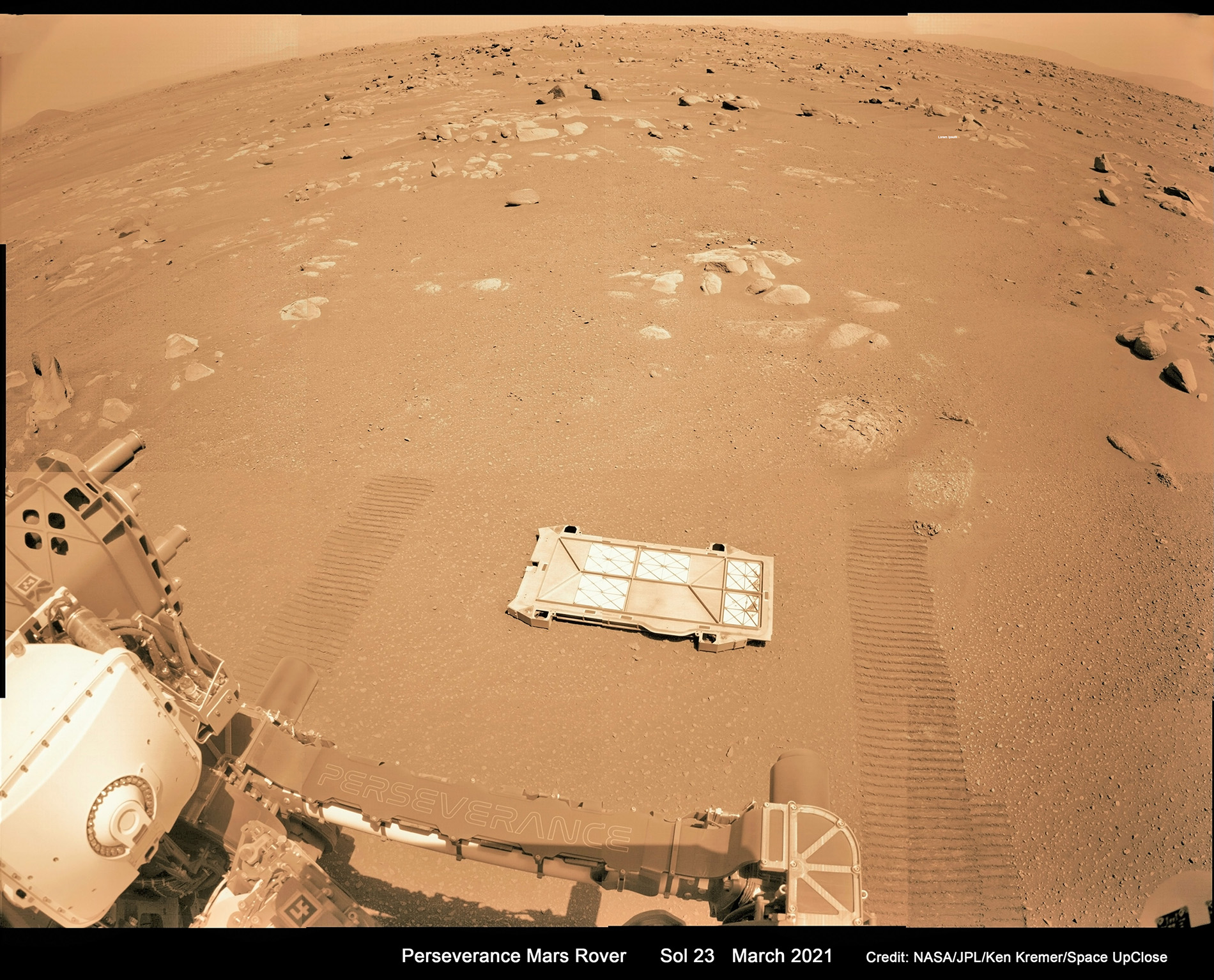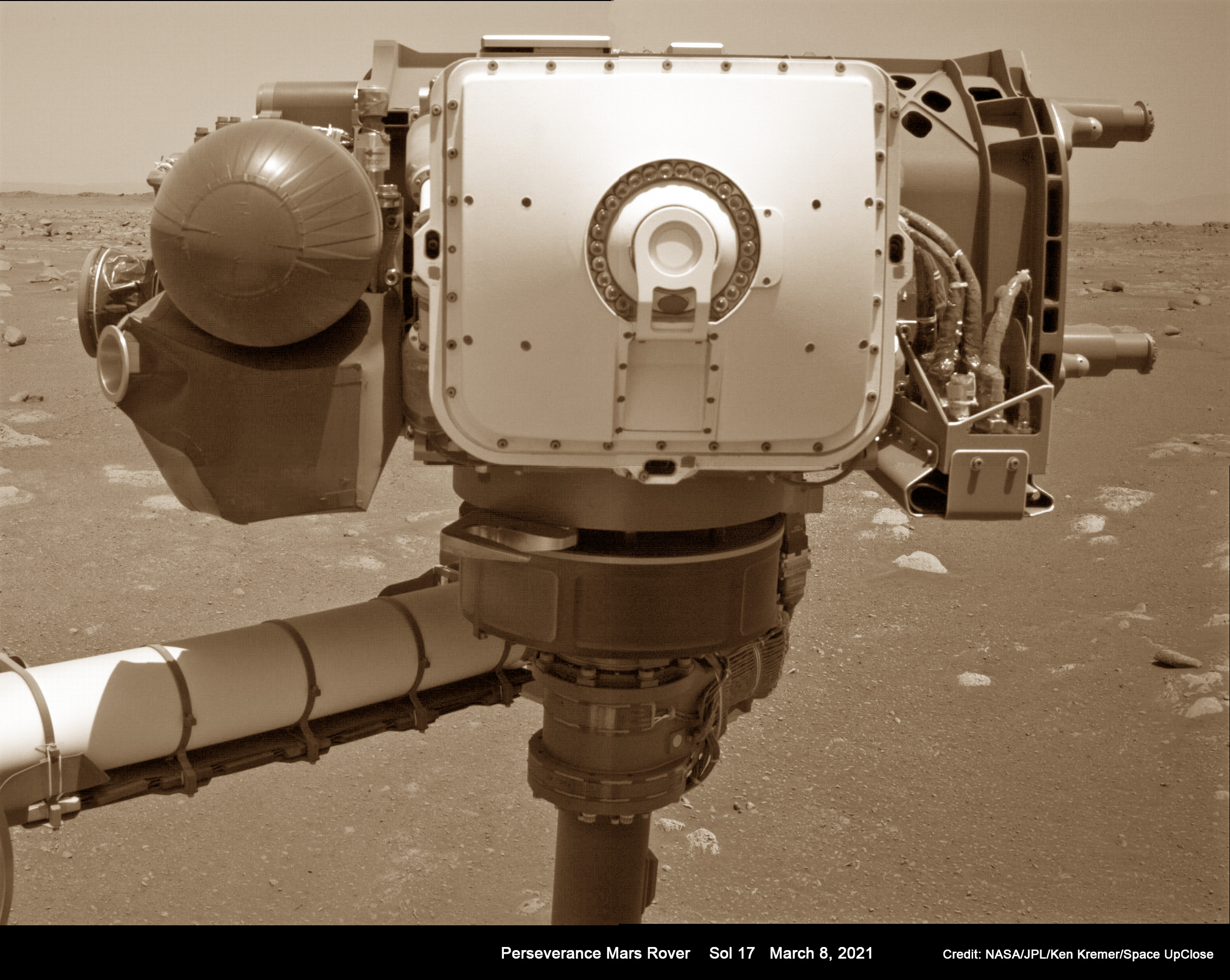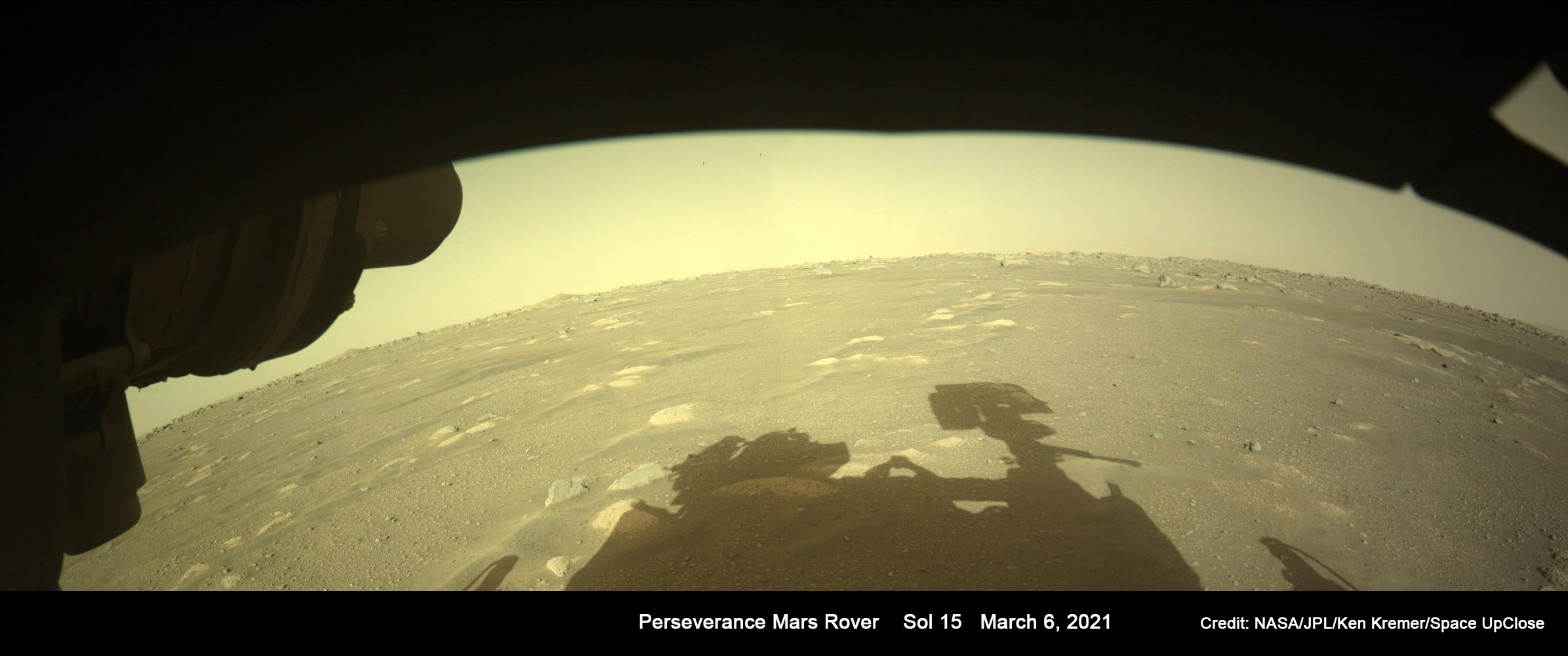
For SpaceUpClose.com & RocketSTEM
CAPE CANAVERAL, FL – In another major mission milestone NASA’s Perseverance rover has just ejected the belly pan cover protecting the Sample Caching System and dropped it flat onto the Martian surface on March 12 and 13 (Sol 21 and 22)- and thereby successfully exposed the sample collection system critical to gathering and storing cored samples of Red Planet soil and rocks in search of signs of life for eventual return to Earth – about a decade from now.
The next Sol, or Martian day, on March 14 (Sol 23) Perseverance drove away a short distance and snapped a new series of 16 raw images with the Navcam navigation camera from which I created beautiful and dramatic new panoramic mosaic from the leftside camera – including the pan cover, wheel tracks, rover deck and wide angle view out to the Red Planet horizon with alien rocks of all shapes in the foreground and Jezero Crater walls in the distance some 2 miles away.
The stunning Sol 23 view shows the rectangular shaped belly pan sampling cover resting a short distance out in front of Perseverance and lying flat on the Red Planet centered in between the left and right front wheels after she drove away
I carefully stitched the Sol 23 Panoramic mosaic together from 16 individual left side navcam black and white raw images and colorized in the view seen above as lead image. Some pixilation is present from the raw images which I have tried to reduce.
With this successful ejection of the protective belly pan cover the team can proceed with check out of the tool and instruments required to core rock and collect and store the samples of interest in the search for life signs for return to Earth – the primary mission goal.
This week, I’m checking out the tools I’ll use for one of my key goals: to collect and store samples that a future mission can bring back to Earth. (1/4) pic.twitter.com/GdOXeA15mv
— NASA's Perseverance Mars Rover (@NASAPersevere) March 17, 2021
“The belly of the rover houses all the equipment and supplies needed to collect samples. It contains a rotating drill carousel, which is a wheel that contains different kinds of drill bits. Next to that are the 43 sample tubes waiting to be filled, according to a NASA description of the sample handling system now exposed.
“While the rover’s big arm reaches out and drills rock, the rover belly is home to a small robotic arm that works as a “lab assistant” to the big arm. The small arm picks up and moves new sample tubes to the drill, and transfers filled sample containers into a space where they are sealed and stored.”
Here is the rover belly mosaic captured by the Sherloc-Watson science camera on the extended robotic arm looking back before and after ejection to the Red Planet surface in a dramatic Gif from the rover team
“A quick-look mosaic my team pulled together of the belly pan, now on the surface of Mars. Up next is to check my sampling system now that its cover panel is off,” Perseverance tweeted.
A quick-look mosaic my team pulled together of the belly pan, now on the surface of Mars. Up next is to check my sampling system now that its cover panel is off.
More images: https://t.co/9X891PBvax pic.twitter.com/nInhndskLO
— NASA's Perseverance Mars Rover (@NASAPersevere) March 13, 2021
Watch this short NASA JPL video showing the location of the ejectable belly pan cover.
“Take a look at this shot taken with my robotic arm. Checking things out before I release the “ejectable belly pan,” Perseverance tweeted.
Take a look at this shot taken with my robotic arm. Checking things out before I release the “ejectable belly pan.”
More images: https://t.co/9X891PBvax pic.twitter.com/vysQivAONs
— NASA's Perseverance Mars Rover (@NASAPersevere) March 12, 2021
This NASA JPL video shows a practice drop of the ejectable belly pan operation carried out as practice and confirmation by the team on Earth.
“I’m getting ready to drop the cover that protects my sampling system. Watch this practice “belly pan” drop from when I was back on Earth,” Perseverance tweeted.
I’m getting ready to drop the cover that protects my sampling system. Watch this practice “belly pan” drop from when I was back on Earth: pic.twitter.com/yXkTvVfunF
— NASA's Perseverance Mars Rover (@NASAPersevere) March 12, 2021
The Sherloc-Watson science camera and drill are located on the robotic arm turret, or hand, present in my Sol 17 mosaic along with the PIXL X-Ray instrument after the first time the arm/turret were raised high of the rover deck – see below.

The 7-foot-long (2.1-meter) robotic arm and science instrument turret was maneuvered up, down and sideways through all 5 degrees of freedom by the robots engineering and science team – all while capturing dramatic imagery backdropped by spectacular views of the Red Planets landscape inside Jezero Crater where she touched down just over 2 weeks on Feb 18, 2021.
The team will continue checking out the science instruments for the next few weeks while also searching for a safe drop zone for the ‘Ingenuity’ Mars helicopter bolted to the robots belly.
The arm/turret mosaic is a follow up to the rover shadow selfie mosaic I created last week.
My Perseverance rover shadow selfie mosaic was also featured at the Space.com space news website – here.

Watch our live and complete ‘Stay Curious’ with live Perseverance landing commentary Feb 18, 2021 as well as earlier programs on Mars Mania on Feb 12.
https://www.facebook.com/175507880819/videos/752176242375043
https://www.facebook.com/175507880819/videos/3246699658764085
Watch Ken’s continuing reports about Mars 2020 Perseverance and Curiosity rovers, Artemis and NASA missions, SpaceX, Starlink, Commercial Crew and Starliner and Crew Dragon and onsite for live reporting of upcoming and recent SpaceX and ULA launches including Crew 1 & 2, Demo-2, ISS, X-37B, Solar Orbiter, NRO spysats and national security missions and more at the Kennedy Space Center and Cape Canaveral Space Force Station.
Stay tuned here for Ken’s continuing Earth and Planetary science and human spaceflight news: www.kenkremer.com –www.spaceupclose.com – twitter @ken_kremer – email: ken at kenkremer.com
Dr. Kremer is a research scientist and journalist based in the KSC area, active in outreach and interviewed regularly on TV and radio about space topics.
………….
Ken’s photos are for sale and he is available for lectures and outreach events
Ken has created hundreds of widely published Mars rover mosaics and lectures also about NASA’s Mars rovers
Please consider supporting Ken’s work by donating at Patreon:
https://www.patreon.com/kenkremer
x



